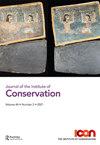Er:YAG激光辐照老化损伤膜的热分布及氧化改性研究
IF 1
0 HUMANITIES, MULTIDISCIPLINARY
引用次数: 5
摘要
摘要本文研究了一个Er:YAG激光脉冲对老化损伤清漆表面和体积的影响。测试的影响范围为0.56至2.4J/cm2,脉冲持续时间为100和300μs。照射后的温度变化通过(a)红外热像仪的实时记录和(b)确定清漆的光学特性来检测,这允许估计线性吸收系数和与激光照射相关的温升。透射和傅里叶变换红外(FTIR)光谱研究捕捉到通过清漆膜的能量传输增加,并分别记录了氢氧化物和碳氢键的减少,这是影响力的函数。FTIR和差示扫描量热法(DSC)实验测定了dammar薄膜的吸收系数和比热容,并用扫描电子显微镜(SEM)对激光光斑进行了概述。提供了光漆对Er:YAG激光辐照响应的证据。本文章由计算机程序翻译,如有差异,请以英文原文为准。
A study on the heat distribution and oxidative modification of aged dammar films upon Er:YAG laser irradiation
Abstract This work shows the impact of one Er:YAG laser pulse to both the surface and bulk of aged dammar varnishes. Tests were performed in fluences ranging from 0.56 to 2.4J/cm2 and pulse durations of 100 and 300μs. Temperature changes upon irradiation were examined by (a) live recordings with an infrared thermal camera, and (b) determining the optical properties of the varnish, which allowed for estimates of the linear absorption coefficient and the temperature rise associated with the laser irradiation. Transmission and Fourier Transform Infrared (FTIR) spectroscopy studies captured increased energy transmissions through varnish films, as well as registering a reduction of hydroxides and carbon–hydrogen bonding as a function of fluence, respectively. FTIR and Differential Scanning Calorimetry (DSC) experimentally determined the absorption coefficient and the specific heat capacity of dammar films, and an overview of laser spots was carried out with Scanning Electron Microscopy (SEM). Evidence on the varnish response to Er:YAG laser irradiation is provided.
求助全文
通过发布文献求助,成功后即可免费获取论文全文。
去求助
来源期刊

Journal of the Institute of Conservation
HUMANITIES, MULTIDISCIPLINARY-
CiteScore
1.50
自引率
0.00%
发文量
22
期刊介绍:
The Journal of the Institute of Conservation is the peer reviewed publication of the Institute of Conservation (Icon). As such, its aims reflect those of Icon, to advance knowledge and education in conservation and achieve the long term preservation and conservation of moveable and immoveable cultural heritage. The Journal provides a collective identity for conservators; it promotes and supports both the profession and professionalism. With international contributions on all aspects of conservation, it is an invaluable resource for the heritage sector. The specific aims of the Journal are to: 1. promote research, knowledge and understanding of cultural heritage conservation through its history, practice and theory 2. provide an international forum to enable and disseminate advances in research, knowledge and understanding relating to conservation and heritage 3. champion and support professional standards of heritage conservation in the UK and internationally 4. provide a permanent record of issues relating to conservation and heritage 5. be financially and operationally sustainable. To achieve these aims, the Journal invites contributions from all those involved in the conservation of cultural heritage and related activities. Areas of interest include understanding cultural heritage materials and their degradation; subject reviews and histories of cultural heritage materials and conservation treatments; new, innovative or improved approaches to conservation and collections care theory, practice, communication, management and training; case studies demonstrating new, innovative or improved approaches; and conservation in its wider context. Submitters are encouraged to demonstrate how their work is of practical application to conservation. To maintain professional standards and promote academic rigour, submissions of articles and shorter notices are subject to an anonymous peer review process.
 求助内容:
求助内容: 应助结果提醒方式:
应助结果提醒方式:


